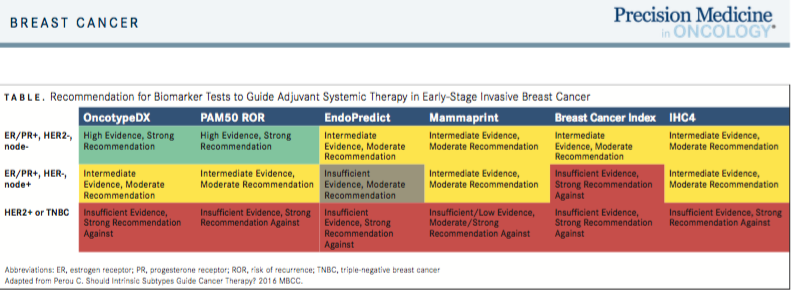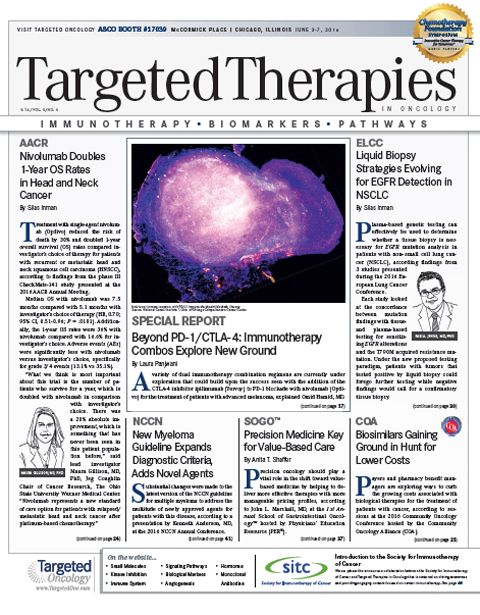Biomarkers, Subtyping Help Guide Neoadjuvant/Adjuvant Breast Cancer Treatment Decisions
For patients with early-stage invasive breast cancer and known estrogen receptor, progesterone receptor, and HER2 status, ASCO's February 2016 release of their evidence-based recommendations helped define appropriate use of biomarker assay results in guiding adjuvant treatment decisions.
1
The recommendations state that beyond utilizing just the ER/PR and HER2 status, results from Oncotype DX, EndoPredict, PAM50, Breast Cancer Index, Mammaprint, IHC4 also have clinical utility in guiding treatment decisions on adjuvant therapy in subgroups of patients with early-stage breast cancer. Specific to each subgroup, the benefits for these tests were most pronounced in patients with ER/PR-positive, HER2-negative and node-negative cancer.
“These guidelines are very helpful because they look at a large number of gene expression tests and determine how they should be used, and what the level of evidence was about each test,” said Charles M. Perou, PhD, professor of Genetics, and Pathology and Laboratory Medicine, Lineberger Comprehensive Cancer Center. “It has really provided some help for the field because there are 8 or 9 of these tests with varying levels of evidence for particular uses. The expert panel did a good job of trying to mesh this all together in a single document.”
The multidisciplinary panel of experts who developed the recommendations conducted a systematic review of literature published from January 2006 to September 2015, identifying 50 relevant studies. They sought to answer whether these tests had clinical utility to help guide adjuvant treatment decisions and which biomarkers were ideal for selecting therapy.
Overall, the guideline suggests that for patients with ER/PR-positive, HER2-negative node-negative disease, clinicians can use the 21-gene recurrence score Oncotype DX, the 12-gene risk score EndoPredict, the PAM50 risk of recurrence score in conjunction with other clinicopathologic variables, Breast Cancer Index, or urokinase plasminogen activator and plasminogen activator inhibitor type 1 to determine if adjuvant systemic therapy will be useful(TABLE).
“Two tests really were put forth with a high level of evidence and a strong recommendation. In general, most of the tests were endorsed as prognostic assays,” said Perou. “There’s good consensus that they’re all good at picking up the good prognosis group and there’s high concordance between them but there’s varying levels of evidence on how you might use that for chemotherapy.”
Interestingly, a strong consensus was not reached for patients who were ER/PR-positive and node-negative. The reason for a lack of recommendation in this space is likely due to the data cutoff for the review, according to Perou.
“There were really no strong endorsements for any of these tests. Quite frankly, there’s not a lot of data in the node-positive setting. In many of these instances, the guideline says more data are needed,” said Perou.
Patients who are HER2-positive or have triple-negative breast cancer (TNBC) should not use any of the reviewed assays to guide decisions on adjuvant systemic therapy, according to the guideline. For these groups, the subtype alone is predictive of response.
“None of the tests were approved for use in HER2-positive patients or patients with triple-negative breast cancer,” said Perou. “The ones that were, in essence, approved for use were in HR-positive/HER2-negative patients, which is still the majority of patients.”
No other specific biomarkersaside from ER, PR, and HER2—were found to demonstrate strong enough evidence to select patients for adjuvant endocrine therapy selection, the guideline noted. These include CYP2D6 polymorphisms, p27 expression, MKI67 gene, TOP2A gene amplification or TOP2A protein expression, CEP17 duplication, TIMP-1, FoxP3, p53, or PTEN.
“It is important to point out that, aside from HER2 testing, there really is no other approved biomarker,” said Perou. “For TNBC, these tests don’t really add to predicting chemotherapy response or prognosis for these patients. The guidelines did a good job of saying, ‘Here is where they can be used and for what, and here is where we don’t recommend them to be used.’”
The use of circulating tumor cells was also advised against as a tool to guide decisions on adjuvant systemic therapy. Tumor-infiltrating lymphocytes should also not be used to guide treatment decisions in patients who are ER/PR-positive, HER2-negative (node-positive or node-negative), HER2-positive, or TNBC.
“It would be helpful to have genomic or genetic tests that may further stratify HER2 or TNBC patients,” said Perou. “My laboratory is working to develop such tests, as are others; however, if you look at TNBC by the PAM50 risk of recurrence score, they are all pretty much called high risk. There is very little prognostication within TNBC for the existing tests.”
BRCA1/2 germline mutations were not considered for the guideline, as there is no direct application to choice of adjuvant therapy at this time, the authors noted. This could change in the future, as clinical trials continue to assess BRCA and PARP inhibition for patients with breast cancer.
Prior to being added to the guideline, new biomarker tests must be shown to contribute clinically useful information beyond what is already provided by clinical or pathologic indicators in standard use, the authors wrote, unless a new test can provide equivalent information at lower cost, less invasively, or with less inconvenience or risk.

GUIDING TREATMENT USING INTRINSIC SUBTYPES
Intrinsic subtyping using the PAM50 risk of recurrence (ROR) score provides information on the biology of the breast cancer, baseline prognosis, and the ability to predict response to endocrine therapy, according to Perou, who helped develop the test. The 6 intrinsic subtypes of breast cancer are normal-like, luminal A, luminal B, HER2-enriched, basal-like, and claudin-low.
The ROR score was validated on 2485 samples from the large ATAC and ABCSG-8 clinical trials.2Of these samples, 193 were excluded, 1654 were node-negative, and 638 were node-positive. The samples were further stratified to those with 1-3 positive nodes (n = 543). In each trial the patients had postmenopausal ER/PR-positive early-stage breast cancer and were treated with 5 years endocrine therapy.
In the high-risk, node-negative group, 20.3% of patients were at risk for recurrence by the ROR score. Using this tool, these patients could be considered ideal candidates for adjuvant chemotherapy. Additionally, 15% and 4.9% of patients were categorized as intermediate- and low-risk, respectively.
In those with 1 to 3 positive nodes, 29.9% of patients were at risk for recurrence in the high-risk group. In the intermediate group, 13.8% were at risk and in the low group 7.9% were at risk. For luminal B node-positive patients, the 10-year risk of recurrence was 31%. For those with luminal A non-positive disease, the 10-year recurrence rate was 11.4%.
“There are patients with 1 to 3 positive nodes who have good outcomes when given endocrine therapy alone,” said Perou. “Where the precise cut point should be between low and intermediate needs a little more work.”
The TAILORx study is attempting to prospectively validate the 21-gene Oncotype DX test. In this study, 10,253 eligible patients were included, with 1626 (15.9%) marked as having favorable gene expression profiles (score <11). Women in the study had HR-positive, HER2-negative node-positive early-stage breast cancer. In the low risk group, chemotherapy was omitted and patients were treated with endocrine therapy alone.
In early findings for the low-risk group published inThe New England Journal of Medicine,3the rate of invasive disease-free survival (DFS) was 93.8% and the distance recurrence-free survival rate was 99.3%. The distant and local recurrence-free survival rate was 98.7% and the overall survival rate was 98%.
The study is still ongoing for the high-risk and intermediate-risk groups. For this study, intermediate risk was indicated as a score of 11 to 25 and high risk was a score of >25. The benefit of chemotherapy in the intermediate group was considered the primary study endpoint.
“The cut points used in TAILORx [for the risk groups] are different than the cut points used in the commercial assay. This complicates, somewhat, the interpretation of this study, which we should keep in mind,” said Perou.
A second study prospectively validated the Oncotype DX assay in patients with ER-positive, HER2-negative early- stage breast cancer with up to 1 positive lymph node.4For this analysis, all patients received endocrine therapy, with chemotherapy omitted for the low-risk group (score ≤11). Chemotherapy was administered to patients at intermediate (score 12-25) and high risk (score >25).
After 35 months of follow-up, the 3-year DFS was 97.4% in the low-risk group versus 91.9% and 97.8% for the high-risk and intermediate arms, respectively. In those specifically with low-risk, node-negative disease, the 3-year DFS rate was 98.4%. In those with 1 positive node, the 3-year DFS was 89.4% in the high-risk group versus 97.2% and 97.9% in the intermediate- and low-risk groups, respectively.
NEOADJUVANT RISK ASSESSMENT
Pathologic complete response (pCR) rates with anthracycline/taxane-based regimens vary depending on PAM50 subtype. In 441 patients not treated with trastuzumab, the pCR ranged from 3% in the Luminal A group to 38% in the basal-like subtypes. Across all patients, the pCR rate was 28%.5
In a second study,6subtypes were analyzed in 957 patients treated with sequential anthracycline and antimicrotubule-based neoadjuvant regimens. In this analysis, the intrinsic subtype was independently associated with pCR. In those who did not achieve a pCR, the best outcomes were still seen in the basal-like groups.
Further looking into this, Perou noted that outcomes were better in those who did not achieve a pCR but were considered in the low-risk group. Based on this, he suggested “There is potentially some value for these risk assessment tools after patients have receive neoadjuvant treatment.”
In addition to retrospective analyses, a prospective study looked at predicting response to neoadjuvant chemotherapy using core needle biopsy samples along with the PAM50 risk assessment assay.7This study looked specifically at those with HR+/HER2-breast cancer and showed similar variety in responses by intrinsic subtype to the retrospective trials. In the Luminal A group, 9.3% of patients responded to neoadjuvant chemotherapy versus a 50% rate in the basal arm.
“Luminal A has the lowest rate and basal-like has the highest rate. This also points out that among the HR-positive, HER2-negatives, there are some basals in theremaybe 10% to 15% of basal- like patients are either ER or PR-positive,” Perou concluded.
References
- Harris LN, Ismaila N, McShane LM, et al. Use of biomarkers to guide decisions on adjuvant systemic therapy for women with early-stage invasive breast cancer: American Society of Clinical Oncology Clinical Practice Guideline.J Clin Oncol. 2016;34(10):1134-1150.
- Gnant M, Dowsett M, Filipits M, et al. Identifying clinically relevant prognostic subgroups in node-positive postmenopausal HR+ early breast cancer patients treated with endocrine therapy: A combined analysis of 2,485 patients from ABCSG-8 and ATAC using the PAM50 risk of recurrence (ROR) score and intrinsic subtype.J Clin Oncol. 2013;31 (suppl; abstr 506).
- Sparano JA, Gray RJ, Makower DF, et al. Prospective validation of a 21-gene expression assay in breast cancer.N Engl J Med. 2015;373(21):2005-2014.
- Gluz O, Nitz UA, Christgen M, et al. West German Study Group Phase III PlanB Trial: First Prospective Outcome Data for the 21-Gene Recurrence Score Assay and Concordance of Prognostic Markers by Central and Local Pathology Assessment [Published online February 29, 2016].J Clin Oncol. doi: 10.1200/JCO.2015.63.5383
- Masuda H, Baggerly KA, Wang Y, et al. Differential response to neoadjuvant chemotherapy among 7 triple-negative breast cancer molecular subtypes.Clin Cancer Res. 2013;19(19):10.1158/1078-0432.CCR-13-0799.
- Prat A, Fan C, Fernandez A, et al. Response and survival of breast cancer intrinsic subtypes following multi-agent neoadjuvant chemotherapy [Published online December 18, 2015].BMC Medicine. DOI: 10.1186/s12916-015-0540-z
- Prat A, Galvan P, Jimenez B, et al. Prediction of Response to Neoadjuvant Chemotherapy Using Core Needle Biopsy Samples with the Prosigna Assay [Published online July 7, 2015]Clin Cancer Res. doi: 10.1158/1078-0432.CCR-15-0630

Controversy Swirls Around the Use of CDK4/6 Inhibitors as Adjuvant Breast Cancer Therapy
January 15th 2025CDK4/6 inhibitors like abemaciclib and ribociclib improve invasive disease-free survival in breast cancer trials, but controversy surrounds study designs, bias, and cost-effectiveness, raising critical questions about their clinical benefit.
Read More